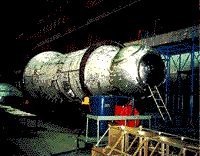| The Zarya
control module, also known by the technical term Functional
Cargo Block and the Russian acronym FGB, will be the first
component launched for the International Space Station and
provide the station's initial propulsion and power. The
42,600-pound pressurized module is scheduled to be launched on a
Russian Proton rocket in November 1998.
|

|
The U.S.-funded
and Russian-built Zarya, which means Sunrise when translated to
English, is a U.S. component of the station although it will be
built and launched by Russia. The module was built by the
Khrunichev State Research and Production Space Center (KhSC) in
Moscow under a subcontract to The Boeing Co. for NASA. Only weeks
after the Zarya reaches orbit, the Space Shuttle Endeavour will
rendezvous with it and attach a U.S.-built connecting module
called Node 1. The Zarya module will provide orientation control,
communications and electrical power attached to the p./img/assive Node
1 for several months while the station awaits launch of the third
component, a Russian-provided crew living quarters and early
station core known as the Service Module. The Service Module will
enhance or replace many functions of the Zarya. Later in the
station's assly sequence, the Zarya module will be used
primarily for its storage capacity and external fuel tanks.

